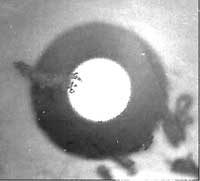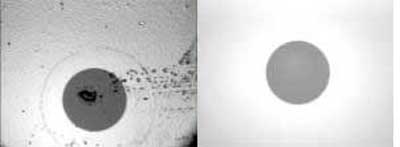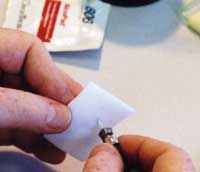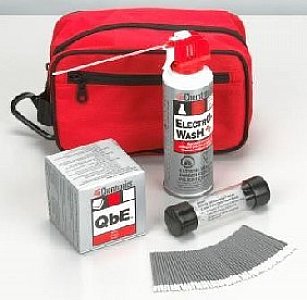Cleaning
Fiber Optic Connections
For
a comprehensive guide to connector inspection and
cleaning, go here.
With fiber optics, the tolerance to dirt or contamination
on the ends of the ferrules of a connector is near zero.
 
From left: dirt, contamination, clean connector
Airborne dirt particles are about the size of the core of
SM fiber and are usually silica based - they may scratch
PC connectors if not removed! Patch panels have mating
adapters that can become contaminated if left open to the
air or scrape off foreign particles under repeated usage.
Test equipment has fiber-bulkhead outputs that need
periodic cleaning, since they may have hundreds of
insertions of test cables in short time frames.
We recommend you always keep dust caps on connectors,
bulkhead splices, patch panels or anything else that is
going to have a connection made with it. Not only will it
prevent additional dust buildup, but it will prevent
contamination from being touched or damaged from dropping.
Always clean connectors before mating, whether for testing
or making network connections.
When testing, we recommend that connectors on both the
reference and tested cables be cleaned before every test,
as every time the connector is exposed to air, it can
accumulate dust. Typical airborne dust is almost the size
of the SM fiber core, so cleaning every time is even more
important than MM. A secondary effect is that if the
connectors are dirty, it can scratch the end finish (most
dirt is silica (sand) based) and cause higher reflectance
if not loss.
Cleaning Connectors
There are several types of cleaners which can be used.
Many companies sell cleaning kits for fiber optics,
including Sticklers, Chemtronics., NetOptics, AFL etc.
(Links below) They are readily available from
distributors. Some are dry, some us cleaning solutions.
They are all good solutions if you follow their directions
carefully and always inspect after cleaning.
 You
may use lint-free pads and isopropyl alcohol to wet-clean
the connectors. Some solvents MIGHT attack epoxy, so only
reagent-grade 99% isopropyl alcohol should be used. Never
use cotton swabs or cloth it will leave threads behind.
Clean and dry the end of the ferrule just before
insertion. If you wet-clean, use a dry lint-free pad to
dry the connector off and then inspect it to ensure it is
clean. You
may use lint-free pads and isopropyl alcohol to wet-clean
the connectors. Some solvents MIGHT attack epoxy, so only
reagent-grade 99% isopropyl alcohol should be used. Never
use cotton swabs or cloth it will leave threads behind.
Clean and dry the end of the ferrule just before
insertion. If you wet-clean, use a dry lint-free pad to
dry the connector off and then inspect it to ensure it is
clean.
Some optical cleaners for lenses may leave residues.
Residues usually attract dirt and make it stick.
We have used Alco Pads which are pure isopropyl alcohol on
lint-free pads for over 20 years with no problems. After
the alcohol evaporates, they are good to dry the ends of
the ferrules after cleaning.
All "canned air" has a liquid propellant and may leave a
residue unless you 1. hold them perfectly level when
spraying and 2. spray for 3-5 seconds before using to
insure that any liquid propellant is expelled from the
nozzle. These cans can be used to blow dust out of
bulkheads with a connector in the other side or an active
device mount (xmit/rcvr). NEVER use compressed air from a
hose (they emit a fine spray of oil from the compressor!)
or blow on them (you breath is full of moisture , not to
mention all those germs!)
A better way to clean these bulkheads is to remove both
connectors and clean with Alco Pads, then use a swab made
of the same material with alcohol on it to clean out the
bulkhead.
Detectors on FO power meters should also be cleaned
occasionally to remove dirt. Take the connector adapter
off and wipe the surface, then air dry or dry with a
lint-free wipe.
Ferrules on the connectors/cables used for testing will
get dirty on the sides as well as the ends by scraping off
the material of the alignment sleeve in the splice
bushing. Some of these sleeves are molded glass-filled
thermoplastic and sold for multimode applications. These
will give you a dirty connector ferrule in 10 insertions.
You can see the front edge of the connector ferrule
getting black. The alignment sleeve will build up an
internal ledge and cause a gap between the mating ferrules
- creating an attenuator!
Use the metal or ceramic alignment sleeve bulkheads only,
especially for testing where you have repeated insertions.
Cleaning contaminated connectors requires aggressive
scrubbing on the ferrule sides with the AlcoPad and
tossing the bulkhead away.
For
a comprehensive guide to connector inspection and
cleaning, go here
LInks
- Ed
Forrest is the guru of cleaning. He's written a number
of books on fiber cleaning - yes, it's a big enough
subject for more than one book - and these are THE
references on cleaning. His website is http://www.fiberopticprecisioncleaning.com/
and he has videos on YouTube.
( Use Code FVCFR80DX for a 20% discount on all
www.createspace.com book
orders.
-
- MicroCare
Sticklers
brand
ITW
Chemtronics
Cleantex
Alco Pads
|

